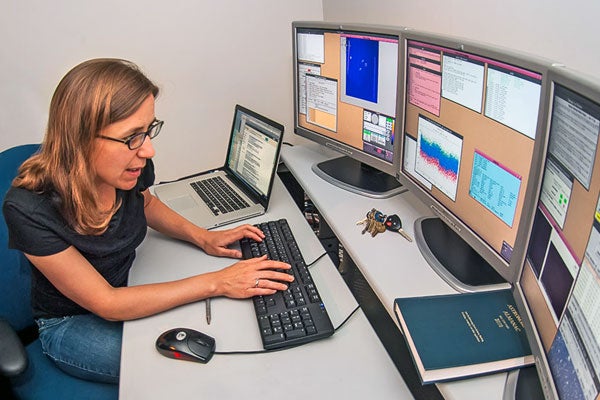
Building better telescopes, understanding diabetes and stroke
Published: June 6, 2013
University of Toronto researchers have won just under $2.5 million in infrastructure funding in the Canada Foundation for Innovation’s latest Leadership Opportunity Fund competition.
Professor Shelley Wright of the Dunlap Institute and the Department of Astronomy and Astrophysics is one of them. Her $259,840 grant will help build a lab on campus that will develop instrumentation for large telescopes.
Telescopes collect light from the sky, and cameras inside them record images. Earth-based telescopes require the intervention of an adaptive optics system, which corrects for the distorting effects of the atmosphere.
“The atmosphere blurs the light that comes to earth,” says Wright, “It dances around. That’s why the stars twinkle. We use adaptive optics to try to correct for that twinkle in real time.”
An adaptive optics system shines a laser into the sky and creates an artificial star about 90 kilometres above the atmosphere. Astronomers study the way the atmosphere bends the light from that artificial star, and an adaptive optics system uses tiny mirrors to correct for it in milliseconds of real time.
Wright develops cameras that go behind adaptive optics systems, to actually capture images.
Adaptive optics technology is already in the world’s largest telescopes, which are in the eight-to-10 metre range. The new lab will advance instrumentation for this current generation of telescopes as well as begin work on a camera for an ambitious 30-metre telescope under construction in Hawaii.
The new telescope will be much larger than any existing instrument.
“It’s about the size of a baseball diamond,” says Wright. “I’m working on a first light instrument to go behind the adaptive optics system in it. When the telescope first collects light from the heavens, we’ll turn on the camera and take the first picture.”
In addition to developing astronomical instrumentation, Wright is an observational astronomer. Her research focuses on galaxies that are about 10 billion light years away.
She calls her work a “marriage” between technology and science discovery.
“I’m discovering new things about the universe, but I’m also advancing technology. The technology allows for new discoveries.”
“The CFI’s continued investment in U of T research is greatly appreciated,” said Professor Paul Young, U of T’s vice-president (research and innovation). “The tools and infrastructure these grants support allow our researchers to conduct some of the world’s most cutting-edge research. Their work will advance our understanding of ourselves and our world as well as lead to outcomes that improve our quality of life.”
Eleven other U of T researchers join Wright in receiving grants to advance infrastructure. They are:
- Judith Andersen, Department of Psychology, University of Toronto Mississauga, “Laboratory for the Study of the Psychophysiological Effects of Stress on Physical Health.”
- Tobin Filleter, Department of Mechanical and Industrial Engineering, “Nanomechanics and Nanotribology Platform for Characterizing Energy Efficient Materials.”
- Penney Gilbert, Institute for Biomaterials and Biomedical Engineering, “Muscle Stem Cell Bioengineering Laboratory.”
- Benjamin Hatton, Department of Materials Science and Engineering, “Microstructured Surfaces and Adaptive Materials Engineering.”
- Prabhat Jha, Centre for Global Health Research and St. Michael’s Hospital, “Integrated Million Death Study e-Platform.”
- George Mochizuki, Department of Physical Therapy and Sunnybrook Research Institute, “Neuromuscular Recovery After Stroke: Assessment and Intervention.”
- Brian Shoichet, Leslie Dan Faculty of Pharmacy, “Structural and Systems Pharmacology Laboratory for Drug Discovery.”
- Marla B. Sokolowski, Department of Biology, University of Toronto Mississauga and Department of Ecology and Evolutionary Biology, “Gene-Environment Interplay Research Laboratory.”
- Michael Wheeler, Departments of Medicine and Physiology and University Health Network, “Creation of the Diabetes Discovery Core to Facilitate Innovative New Directions in Understanding Diabetes Pathophysiology and in Developing New Clinical Modalities to Manage the Disease.”
- Paul Yoo, Institute for Biomaterials and Biomedical Engineering, “Electrical Neuromodulation of Spinal and Supraspinal Reflexes for Treatment of Lower Urinary Tract Dysfunction.”
- Yeni Yücel, Department of Ophthalmology and Vision Sciences and St. Michael’s Hospital, “Tracking Nanoparticles with Whole-Animal Imaging and Hyperspectral Microscopy: A Novel Strategy for Identifying Biomarkers and Treating Diabetes.”
Jenny Hall is a writer with the Office of the Vice-President, Research and Innovation



